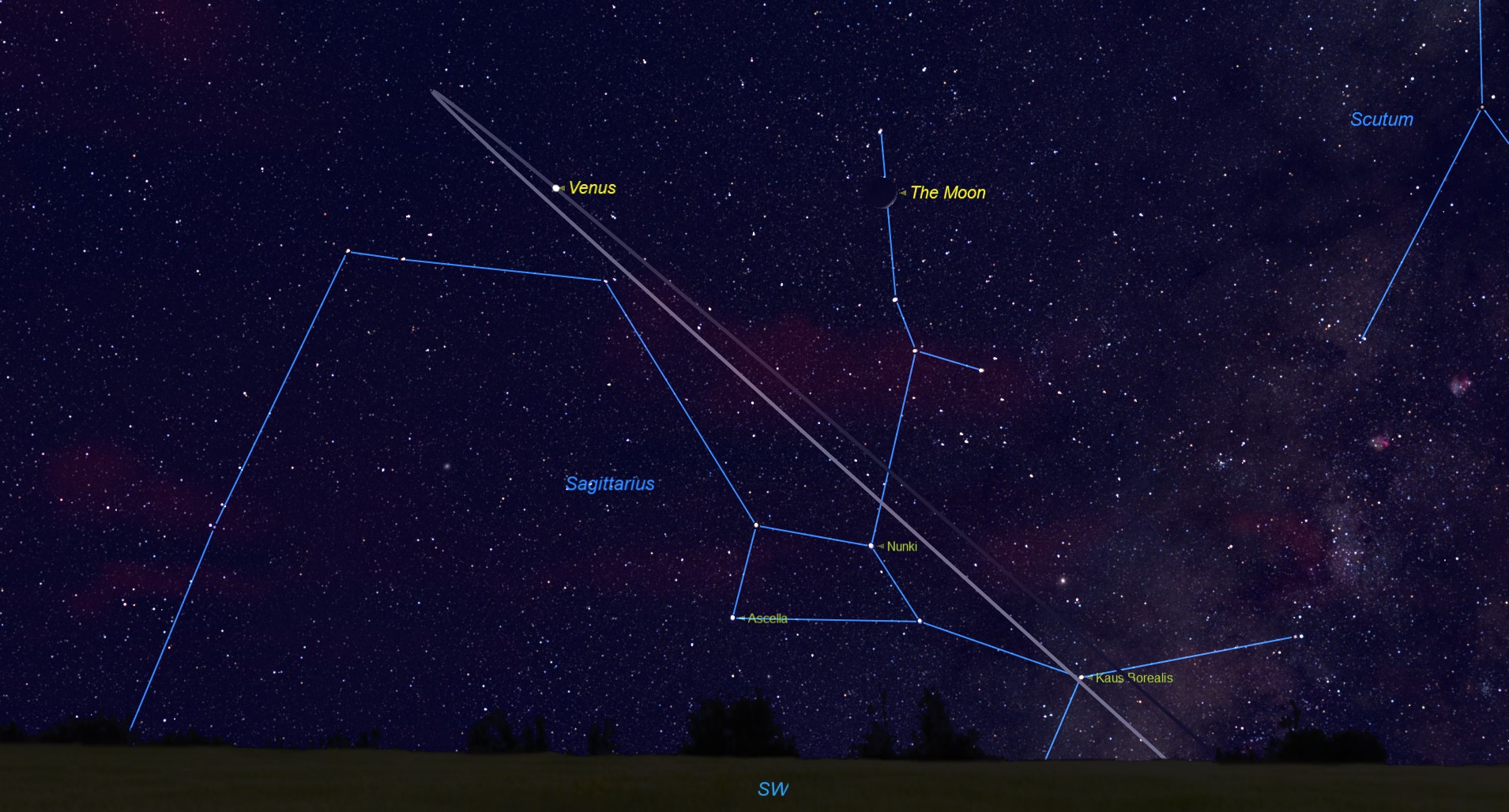See Venus and the Moon Pair Up Saturday Night

Saturday evening (Dec. 3) will be another one of those special occasions when the two brightest objects in the night sky get together. This event will likely attract a lot of attention, even from people who don't normally spend much time gazing up at the sky.
If you face south-southwest about 45 minutes after sunset during midtwilight, you'll see a beautiful crescent moon. And floating 7 degrees below and slightly to its right, you'll find the dazzling evening star: the planet Venus. (Remember, your clenched fist is equal to roughly 10 degrees when held at arm's length.)
Lately, Venus has been calling attention to itself as soon as the sun has slipped below the horizon, dazzling in the south-southwest sky, about one-quarter of the way up from the horizon to the overhead point. [Venus and Mars After Sunset and More: Dec. 2016 Skywatching Video]
Predictably, I've gotten quite a few inquiries about Venus in recent days. Typically, these questions have gone something like this: "I was out walking last week, and was sure I saw a UFO. Or maybe it was the International Space Station. Is there anything that could explain this sighting?"
Venus climbs higher
Some folks are rather surprised when they find out that Venus has been an evening object since midsummer. And yet, most people are getting their first good look at the planet now. Of course, several months ago, Venus was considerably lower in the western sky, and setting much closer to sunset.
But the best is yet to come!
Through the rest of December and into January, Venus will climb progressively higher in the sky and consequently will set later after sundown. On Jan. 12, Venus will arrive at its greatest eastern elongation, or its greatest angular distance east of the sun. Just a few days later, the planet will be setting almost 4 full hours after the sun. And during the first 10 days of February, Venus will stand 40 degrees above the southwest horizon at sunset, soaring as high as it will get for this current evening apparition.
Get the Space.com Newsletter
Breaking space news, the latest updates on rocket launches, skywatching events and more!
Illusion of perspective
Keep in mind that what you will be seeing in Saturday's sky is an illusion created by the geometry of the positions of Venus and the moon as viewed from an Earthly perspective. The crescent moon, 18 percent illuminated, is located 245,200 miles (394,600 kilometers) from Earth. But brilliant Venus is nearly 370 times farther away, at 90 million miles (145 million km).
The "dynamic duo" do not appear particularly close to each other in the sky, but their brilliance and alignment will nonetheless still make for an eye-catching sight.
Call it a "celestial ornament" for this holiday season.
Editor's note: If you have an amazing skywatching photo you'd like to share it with Space.com and our news partners for a possible story or image gallery, please contact managing editor Tariq Malik at spacephotos@space.com.
Joe Rao serves as an instructor and guest lecturer at New York's Hayden Planetarium. He writes about astronomy for Natural History magazine, the Farmer's Almanac and other publications, and he is also an on-camera meteorologist for News 12 Westchester, N.Y. Follow us @Spacedotcom, Facebook or Google+. Originally published on Space.com.
Join our Space Forums to keep talking space on the latest missions, night sky and more! And if you have a news tip, correction or comment, let us know at: community@space.com.

Joe Rao is Space.com's skywatching columnist, as well as a veteran meteorologist and eclipse chaser who also serves as an instructor and guest lecturer at New York's Hayden Planetarium. He writes about astronomy for Natural History magazine, Sky & Telescope and other publications. Joe is an 8-time Emmy-nominated meteorologist who served the Putnam Valley region of New York for over 21 years. You can find him on Twitter and YouTube tracking lunar and solar eclipses, meteor showers and more. To find out Joe's latest project, visit him on Twitter.









